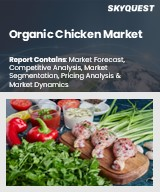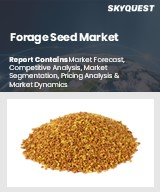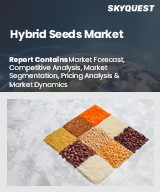
|
시장보고서
상품코드
1725173
세계의 탄소 중립 농업 시장 예측(-2032년) : 농업 유형별, 탄소 중립 전략별, 기술별, 최종 사용자별, 지역별 분석Carbon Neutral Farming Market Forecasts to 2032 - Global Analysis By Farming Type (Livestock Farming, Crop Farming, Aquaculture, Agroforestry and Other Farming Types), Carbon Neutral Strategy, Technology, End User and By Geography |
||||||
Stratistics MRC에 따르면 세계의 탄소 중립 농업 시장은 예측 기간 동안 15.2%의 연평균 복합 성장률(CAGR)로 성장할 것으로 예상됩니다.
탄소 중립 농업은 배출되는 이산화탄소량과 대기에서 제거되는 이산화탄소량의 균형을 맞추어 최종적으로 넷 제로 탄소 배출을 달성하는 것을 목적으로 한 농법입니다. 윤작, 아그로포레스트리, 유기농법등의 수법을 통합하는 것으로, 탄소 중립 농업은 기후 변화에 대항해, 토양의 건전성을 높여, 생물 다양성을 촉진하는 것과 동시에, 장기적인 식량 안보와 환경의 지속가능성을 지원합니다.
기후 변화 완화에 대한 관심 증가
환경 문제에 대한 관심과 규제 당국의 압력으로 인해 시장은 기후 변화 완화를 중시하는 경향이 커지고 있습니다. 이러한 움직임은 토양의 건전성과 생산성을 높이면서 온실가스 배출을 줄이는 것을 목표로 하고 있습니다.
표준화된 규제와 틀의 부족
시장에는 표준화된 규제나 틀이 없기 때문에 탄소 배출량의 측정, 검증, 보고에 일관성이 없는 등 큰 과제가 있습니다. 명확한 지침이 없으면 탄소 중립 주장의 신뢰성이 약해지고 지속 가능한 농법 채택이 지연되고 의미있는 기후 변화 대책을 추진하는 시장의 가능성이 손상됩니다.
재생 농업 기술 채용
생산자가 기후 변화와 싸우는 지속가능한 해결책을 모색하는 중, 재생농업기술의 채용이 시장에서 기세를 늘리고 있습니다. 친환경 식품에 대한 소비자 수요가 증가하고 지속 가능한 농업을 지원하는 정부 인센티브도 있으며, 재생 농업은 농업 부문에서 장기적인 탄소 중립을 달성하기위한 기본 전략이되고 있습니다.
단기 수율 감소 가능성
단기적으로 수율이 감소할 가능성은 탄소 중립 농법을 채용하는데 있어서 큰 과제가 됩니다. 이런 단기 손실은 특히 경제적 완충액의 부족한 영세 농가에서의 채용을 억제하고 결국 시장의 성장을 둔화하고 지속 가능한 농법이 환경에 초래하는 이익을 지연시킬 수 있습니다.
COVID-19의 영향
COVID-19의 대유행은 세계의 농업 시스템을 혼란시켜 시장에 영향을 주었습니다.락 다운이나 여행 제한이 노동력 부족, 공급 체인의 중단, 시장의 폐쇄로 이어져, 농가가 지속 가능한 농법을 채용하는 능력에 영향을 주었습니다. 하지만 이 위기는 또한 현지산의 지속가능한 식량원에 대한 관심을 가속화하여 친환경 제품에 대한 소비자 행동의 변화를 촉진했습니다.
예측 기간 동안 수산 양식 분야가 최대가 될 것으로 예상
예측 기간 동안 수산 양식 분야가 가장 큰 시장 점유율을 차지할 것으로 예측됩니다. 또한 재생 가능 에너지를 동력원으로 하는 에어레이터의 양식 사업에의 채용은 화석 연료에의 의존을 한층 더 최소화합니다.
예측기간 동안 재생농업 분야가 가장 높은 CAGR이 예상
예측 기간 동안 재생 농업 분야가 가장 높은 성장률을 보일 것으로 예측됩니다. 이 분야는 5,000억 유로의 탄소배출권 시장을 창출할 것으로 예측되고 있으며, 농가가 이러한 지속 가능한 수법을 채용하는 인센티브가 되고 있습니다.
최대 점유율을 차지하는 지역:
예측 기간 동안 아시아태평양은 환경 의식 증가, 정부 인센티브, 지속 가능한 농업 관행 채택에 견인되어 최대 시장 점유율을 차지할 것으로 예측됩니다. 인도, 베트남, 호주와 같은 국가는 재생 농업, 정밀 관개, 탄소 오프셋 프로그램과 같은 이니셔티브를 통해 마이그레이션을 주도하고 있습니다. 이 성장은 농업 기술과 탄소 신용 시스템에 대한 투자를 통해 지원되며이 지역은 세계의 지속 가능한 농업에서 주요 기업으로 자리 잡고 있습니다.
CAGR이 가장 높은 지역:
예측 기간 동안 북미가 가장 높은 CAGR을 보여줄 것으로 예측됩니다. 비용과 검증의 복잡성과 같은 과제에도 불구하고, 시장은 기술의 진보와 기업의 투자에 의해 확대되고 있습니다.
무료 사용자 정의 서비스:
이 보고서를 구독하는 고객은 다음 무료 맞춤설정 옵션 중 하나를 사용할 수 있습니다.
- 기업 프로파일
- 추가 시장 기업의 종합적 프로파일링(3개사까지)
- 주요 기업의 SWOT 분석(3개사까지)
- 지역 세분화
- 고객의 관심에 응한 주요국 시장 추계 및 예측, CAGR(주: 타당성 확인에 따름)
- 경쟁 벤치마킹
- 제품 포트폴리오, 지리적 존재, 전략적 제휴에 기반한 주요 기업 벤치마킹
목차
제1장 주요 요약
제2장 서문
- 개요
- 이해관계자
- 조사 범위
- 조사 방법
- 데이터 마이닝
- 데이터 분석
- 데이터 검증
- 조사 접근
- 조사 자료
- 1차 조사 자료
- 2차 조사 정보원
- 전제조건
제3장 시장 동향 분석
- 성장 촉진요인
- 억제요인
- 기회
- 위협
- 기술 분석
- 최종 사용자 분석
- 신흥 시장
- COVID-19의 영향
제4장 Porter's Five Forces 분석
- 공급기업의 협상력
- 구매자의 협상력
- 대체품의 위협
- 신규 참가업체의 위협
- 경쟁 기업간 경쟁 관계
제5장 세계의 탄소 중립 농업 시장 : 농업 유형별
- 축산
- 유제품
- 소
- 가금
- 돼지
- 농작물 재배
- 곡물
- 지방종자 및 콩류
- 과일 및 채소
- 양식업
- 아그로포레스트리
- 기타 농업 유형
제6장 세계의 탄소 중립 농업 시장 : 탄소 중립 전략별
- 탄소 상쇄
- 식목
- 신재생에너지 크레딧
- 카본 인세팅
- 농장에서의 재생 가능 에너지
- 토양탄소 고정
- 배출 감축 기술
- 정밀농업
- 메탄 삭감 사료 첨가물
- 저배출 비료
- 재생 농업
- 불경기 농법
- 커버 크로핑
- 윤작
- 유기적이고 지속 가능한 투입물
- 바이오 비료
- 바이오 농약
제7장 세계의 탄소 중립 농업 시장 : 기술별
- 정밀농업
- 드론
- IoT 센서
- GPS와 GIS
- 리모트 센싱 및 AI
- 신재생에너지 솔루션
- 태양광 발전 관개
- 바이오가스 소화장치
- 탄소 모니터링 툴
- 탄소 발자국 추적 소프트웨어
- 수명 주기 평가 도구
제8장 세계의 탄소 중립 농업 시장 : 최종 사용자별
- 농가 및 생산자
- NGO 및 환경단체
- 아그리텍 기업
- 정부 및 규제기관
- 식음료 기업
- 기타 최종 사용자
제9장 세계의 탄소 중립 농업 시장 : 지역별
- 북미
- 미국
- 캐나다
- 멕시코
- 유럽
- 독일
- 영국
- 이탈리아
- 프랑스
- 스페인
- 기타 유럽
- 아시아태평양
- 일본
- 중국
- 인도
- 호주
- 뉴질랜드
- 한국
- 기타 아시아태평양
- 남미
- 아르헨티나
- 브라질
- 칠레
- 기타 남미
- 중동 및 아프리카
- 사우디아라비아
- 아랍에미리트(UAE)
- 카타르
- 남아프리카
- 기타 중동 및 아프리카
제10장 주요 발전
- 계약, 파트너십, 협업, 합작투자
- 인수와 합병
- 신제품 발매
- 사업 확대
- 기타 주요 전략
제11장 기업 프로파일링
- McDonald's
- Astarta Holding
- Symbrosia
- Agarwood Eco Capital
- Auga Group
- Australian Farming Services
- Zero Carbon Farms
- Growlink
- Mitsui & Co.
- AeroFarms
- Carbon Farming Foundation
- Future Farming Collective
- Sustainable Agriculture Initiative
- Carbon Neutral Ag
- Regenerative Agriculture Alliance
- Cool Farm Alliance
According to Stratistics MRC, the Global Carbon Neutral Farming Market is growing at a CAGR of 15.2% during the forecast period. Carbon neutral farming is the agricultural practices that aim to balance the amount of carbon dioxide emitted with the amount removed from the atmosphere, ultimately achieving net-zero carbon emissions. This is done through techniques such as using renewable energy, enhancing soil carbon storage, reducing synthetic fertilizer use, and adopting sustainable land management. By integrating methods like crop rotation, agroforestry, and organic farming, carbon neutral farming helps combat climate change, improves soil health, and promotes biodiversity, while supporting long-term food security and environmental sustainability.
Market Dynamics:
Driver:
Growing focus on climate change mitigation
The market is witnessing growing emphasis on climate change mitigation, driven by rising environmental concerns and regulatory pressures. Farmers and agribusinesses are adopting sustainable practices like carbon sequestration, precision agriculture, and renewable energy integration. These efforts aim to reduce greenhouse gas emissions while enhancing soil health and productivity. Consumer demand for eco-friendly products further accelerates this transition, positioning carbon-neutral farming as a key solution to combat climate change.
Restraint:
Lack of standardized regulations and frameworks
The lack of standardized regulations and frameworks in the market creates significant challenges, including inconsistency in measurement, verification, and reporting of carbon emissions. This hinders farmers' ability to access carbon credits and discourages investment from stakeholders unsure of long-term returns. Without clear guidelines, the credibility of carbon neutral claims is weakened, slowing the adoption of sustainable practices and undermining the market's potential to drive meaningful climate action.
Opportunity:
Adoption of regenerative farming techniques
The adoption of regenerative farming techniques is gaining momentum in the market as producers seek sustainable solutions to combat climate change. These practices, including cover cropping, reduced tillage, and rotational grazing, enhance soil health, increase carbon sequestration, and reduce emissions. With growing consumer demand for eco-friendly food and government incentives supporting sustainable agriculture, regenerative farming is becoming a cornerstone strategy in achieving long-term carbon neutrality in the agricultural sector.
Threat:
Potential for reduced yields in the short term
The potential for reduced yields in the short term poses a major challenge to the adoption of carbon neutral farming practices. Transitioning to methods like reduced chemical use or regenerative techniques can initially lower productivity, impacting farmers' income and food supply. This short-term loss may discourage adoption, especially among smallholders with limited financial buffers, ultimately slowing the market's growth and delaying the environmental benefits of sustainable agricultural practices.
Covid-19 Impact
The COVID-19 pandemic disrupted global agricultural systems, affecting the market. Lockdowns and travel restrictions led to labor shortages, supply chain interruptions, and market closures, impacting farmers' ability to adopt sustainable practices. However, the crisis also accelerated interest in local and sustainable food sources, prompting a shift in consumer behavior towards eco-friendly products. This dual impact has both challenged and catalyzed the transition to carbon-neutral agriculture.
The aquaculture segment is expected to be the largest during the forecast period
The aquaculture segment is expected to account for the largest market share during the forecast period. Innovations such as Skretting Italy's carbon-neutral aquafeed portfolio, which utilizes responsibly sourced ingredients and compensates for remaining emissions through carbon credits, exemplify this shift. Additionally, the adoption of renewable energy-powered aerators in aquaculture operations further minimizes reliance on fossil fuels. These efforts collectively contribute to a more sustainable and climate-resilient aquaculture sector.
The regenerative agriculture segment is expected to have the highest CAGR during the forecast period
Over the forecast period, the regenerative agriculture segment is predicted to witness the highest growth rate. Techniques such as cover cropping, no-till farming, crop rotation, and agroforestry not only restore ecosystems but also improve resilience to climate impacts and reduce dependency on synthetic inputs. The sector is projected to generate a €500 billion carbon credit market, incentivizing farmers to adopt these sustainable practices. With increasing policy support and corporate investment, regenerative agriculture is poised to be a cornerstone of sustainable food systems.
Region with largest share:
During the forecast period, the Asia Pacific region is expected to hold the largest market share driven by increasing environmental awareness, government incentives, and the adoption of sustainable agricultural practices. Countries like India, Vietnam, and Australia are leading the transition through initiatives such as regenerative agriculture, precision irrigation, and carbon offset programs. This growth is further supported by investments in agri-tech and carbon credit systems, positioning the region as a key player in global sustainable agriculture.
Region with highest CAGR:
Over the forecast period, the North America region is anticipated to exhibit the highest CAGR. Farmers are adopting carbon sequestration techniques, regenerative agriculture, and precision farming to reduce emissions. Government initiatives and incentives support this transition, encouraging eco-friendly practices. Despite challenges like high costs and verification complexities, the market is expanding with technological advancements and corporate investments. As demand for sustainable food production rises, carbon-neutral farming is expected to play a crucial role in shaping North America's agricultural future.
Key players in the market
Some of the key players profiled in the Carbon Neutral Farming Market include McDonald's, Astarta Holding, Symbrosia, Agarwood Eco Capital, Auga Group, Australian Farming Services, Zero Carbon Farms, Growlink, Mitsui & Co., AeroFarms, Carbon Farming Foundation, Future Farming Collective, Sustainable Agriculture Initiative, Carbon Neutral Ag, Regenerative Agriculture Alliance and Cool Farm Alliance.
Key Developments:
In March 2025, A new project called "Routes to Regen" has been launched by members of the Sustainable Markets Initiative, including McDonald's and several other companies, to examine ways to scale regenerative farming practices globally.
Mitsui & Co., Ltd., a Berkeley, California-based startup developing E-Jet(R) fuel, a synthetic sustainable aviation fuel (SAF) made from clean energy, water, and CO2. Synthetic fuels are liquid fuels produced through chemical and catalytic reactions. The ingredients are green hydrogen, which is made by electrolyzing water using clean energy, and CO2.
Farming Types Covered:
- Livestock Farming
- Crop Farming
- Aquaculture
- Agroforestry
- Other Farming Types
Carbon Neutral Strategy Covered:
- Carbon Offsetting
- Carbon Insetting
- Emission Reduction Technologies
- Regenerative Agriculture
- Organic & Sustainable Inputs
Technologies Covered:
- Precision Agriculture
- Remote Sensing & AI
- Renewable Energy Solutions
- Carbon Monitoring Tools
End Users Covered:
- Farmers & Producers
- NGOs & Environmental Groups
- Agritech Companies
- Government & Regulatory Bodies
- Food & Beverage Corporations
- Other End Users
Regions Covered:
- North America
- US
- Canada
- Mexico
- Europe
- Germany
- UK
- Italy
- France
- Spain
- Rest of Europe
- Asia Pacific
- Japan
- China
- India
- Australia
- New Zealand
- South Korea
- Rest of Asia Pacific
- South America
- Argentina
- Brazil
- Chile
- Rest of South America
- Middle East & Africa
- Saudi Arabia
- UAE
- Qatar
- South Africa
- Rest of Middle East & Africa
What our report offers:
- Market share assessments for the regional and country-level segments
- Strategic recommendations for the new entrants
- Covers Market data for the years 2024, 2025, 2026, 2028, and 2032
- Market Trends (Drivers, Constraints, Opportunities, Threats, Challenges, Investment Opportunities, and recommendations)
- Strategic recommendations in key business segments based on the market estimations
- Competitive landscaping mapping the key common trends
- Company profiling with detailed strategies, financials, and recent developments
- Supply chain trends mapping the latest technological advancements
Free Customization Offerings:
All the customers of this report will be entitled to receive one of the following free customization options:
- Company Profiling
- Comprehensive profiling of additional market players (up to 3)
- SWOT Analysis of key players (up to 3)
- Regional Segmentation
- Market estimations, Forecasts and CAGR of any prominent country as per the client's interest (Note: Depends on feasibility check)
- Competitive Benchmarking
- Benchmarking of key players based on product portfolio, geographical presence, and strategic alliances
Table of Contents
1 Executive Summary
2 Preface
- 2.1 Abstract
- 2.2 Stake Holders
- 2.3 Research Scope
- 2.4 Research Methodology
- 2.4.1 Data Mining
- 2.4.2 Data Analysis
- 2.4.3 Data Validation
- 2.4.4 Research Approach
- 2.5 Research Sources
- 2.5.1 Primary Research Sources
- 2.5.2 Secondary Research Sources
- 2.5.3 Assumptions
3 Market Trend Analysis
- 3.1 Introduction
- 3.2 Drivers
- 3.3 Restraints
- 3.4 Opportunities
- 3.5 Threats
- 3.6 Technology Analysis
- 3.7 End User Analysis
- 3.8 Emerging Markets
- 3.9 Impact of Covid-19
4 Porters Five Force Analysis
- 4.1 Bargaining power of suppliers
- 4.2 Bargaining power of buyers
- 4.3 Threat of substitutes
- 4.4 Threat of new entrants
- 4.5 Competitive rivalry
5 Global Carbon Neutral Farming Market, By Farming Type
- 5.1 Introduction
- 5.2 Livestock Farming
- 5.2.1 Dairy
- 5.2.2 Cattle
- 5.2.3 Poultry
- 5.2.4 Swine
- 5.3 Crop Farming
- 5.3.1 Cereals & grains
- 5.3.2 Oilseeds & pulses
- 5.3.3 Fruits & vegetables
- 5.4 Aquaculture
- 5.5 Agroforestry
- 5.6 Other Farming Types
6 Global Carbon Neutral Farming Market, By Carbon Neutral Strategy
- 6.1 Introduction
- 6.2 Carbon Offsetting
- 6.2.1 Tree Planting
- 6.2.2 Renewable Energy Credits
- 6.3 Carbon Insetting
- 6.3.1 On-Farm Renewable Energy
- 6.3.2 Soil Carbon Sequestration
- 6.4 Emission Reduction Technologies
- 6.4.1 Precision Farming
- 6.4.2 Methane-Reducing Feed Additives
- 6.4.3 Low-Emission Fertilizers
- 6.5 Regenerative Agriculture
- 6.5.1 No-Till Farming
- 6.5.2 Cover Cropping
- 6.5.3 Crop Rotation
- 6.6 Organic & Sustainable Inputs
- 6.6.1 Biofertilizers
- 6.6.2 Biopesticides
7 Global Carbon Neutral Farming Market, By Technology
- 7.1 Introduction
- 7.2 Precision Agriculture
- 7.2.1 Drones
- 7.2.2 IoT Sensors
- 7.2.3 GPS & GIS
- 7.3 Remote Sensing & AI
- 7.4 Renewable Energy Solutions
- 7.4.1 Solar-Powered Irrigation
- 7.4.2 Biogas Digesters
- 7.5 Carbon Monitoring Tools
- 7.5.1 Carbon Footprint Tracking Software
- 7.5.2 Lifecycle Assessment Tools
8 Global Carbon Neutral Farming Market, By End User
- 8.1 Introduction
- 8.2 Farmers & Producers
- 8.3 NGOs & Environmental Groups
- 8.4 Agritech Companies
- 8.5 Government & Regulatory Bodies
- 8.6 Food & Beverage Corporations
- 8.7 Other End Users
9 Global Carbon Neutral Farming Market, By Geography
- 9.1 Introduction
- 9.2 North America
- 9.2.1 US
- 9.2.2 Canada
- 9.2.3 Mexico
- 9.3 Europe
- 9.3.1 Germany
- 9.3.2 UK
- 9.3.3 Italy
- 9.3.4 France
- 9.3.5 Spain
- 9.3.6 Rest of Europe
- 9.4 Asia Pacific
- 9.4.1 Japan
- 9.4.2 China
- 9.4.3 India
- 9.4.4 Australia
- 9.4.5 New Zealand
- 9.4.6 South Korea
- 9.4.7 Rest of Asia Pacific
- 9.5 South America
- 9.5.1 Argentina
- 9.5.2 Brazil
- 9.5.3 Chile
- 9.5.4 Rest of South America
- 9.6 Middle East & Africa
- 9.6.1 Saudi Arabia
- 9.6.2 UAE
- 9.6.3 Qatar
- 9.6.4 South Africa
- 9.6.5 Rest of Middle East & Africa
10 Key Developments
- 10.1 Agreements, Partnerships, Collaborations and Joint Ventures
- 10.2 Acquisitions & Mergers
- 10.3 New Product Launch
- 10.4 Expansions
- 10.5 Other Key Strategies
11 Company Profiling
- 11.1 McDonald's
- 11.2 Astarta Holding
- 11.3 Symbrosia
- 11.4 Agarwood Eco Capital
- 11.5 Auga Group
- 11.6 Australian Farming Services
- 11.7 Zero Carbon Farms
- 11.8 Growlink
- 11.9 Mitsui & Co.
- 11.10 AeroFarms
- 11.11 Carbon Farming Foundation
- 11.12 Future Farming Collective
- 11.13 Sustainable Agriculture Initiative
- 11.14 Carbon Neutral Ag
- 11.15 Regenerative Agriculture Alliance
- 11.16 Cool Farm Alliance



















